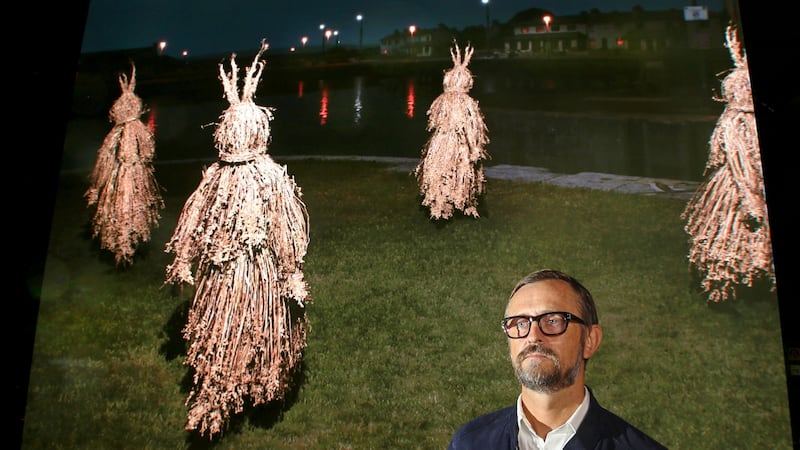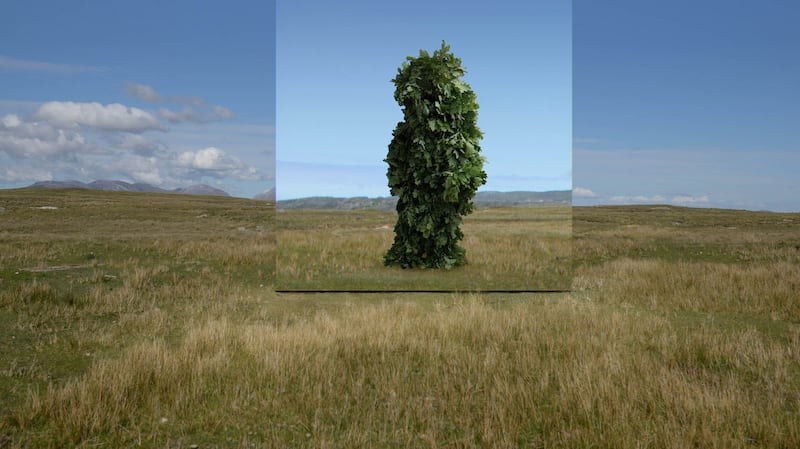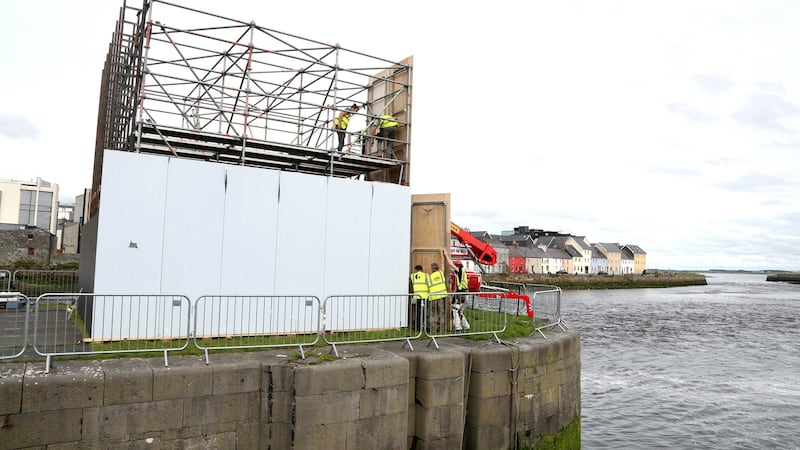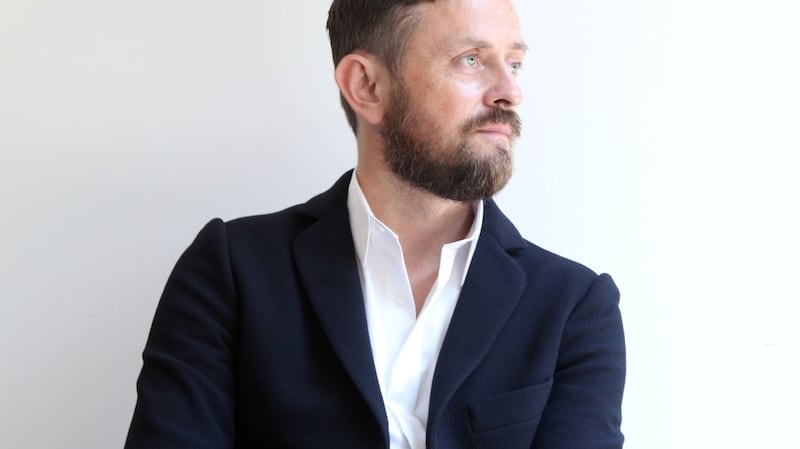"It's a good day on the wall," says John Gerrard. He's referring to the huge LED screen across from the stage where we're sitting. We are in Studio@5, a massive new rehearsal space in Claregalway, and we are surrounded by technology. The screen, which Gerrard has dubbed "the wall", casts a glow over us as we talk. "It throws light into the world," says the artist. "And it gives it an incredible luminosity, which means it can be seen in the light of day."
The wall shows an image of Claddagh Quay in nearby Galway city, a grassy spit of land, where the Corrib meets the sea, with boats bobbing at anchor, and Spanish Arch across the way. On screen, the sun is setting and shadows are lengthening. In the foreground, four figures clad in straw costumes are enacting a processional dance. Gerrard gets up to do something on one of the computers, and a line of code scrolls down the wall. It is deeply fascinating and, masks and hand sanitiser aside, it feels oddly normal – to be watching as a large-scale art work comes into being.
Gerrard is one of Ireland's most successful contemporary artists and his work is owned by institutions from the Tate to MoMa
It's not normal of course. Against the vastness of Covid-19, the arts have shrunk. What work there is, is generally small. Safety has banished spectacle. But even in a pre-Covid world, Mirror Pavilion, would have been spectacular. Delayed, like its commissioners, the Galway International Arts Festival (GIAF) for Galway's European Capital of Culture 2020, it is now being finalised, tweaked and perfected, ahead of its launch next week.
When I spoke to Gerrard, back at the start of the year, an early concern was that the screen, being made to order in China, might not make it in time. That seems an age ago. Now, as we talk, along with GIAF director Paul Fahy, different issues clash. New and confusing Covid-19 restrictions have just been announced, and Storm Ellen is on its way. Later, we will walk out to Claddagh Quay where production manager Adam Fitzsimons has been taking down the vast scaffold that will create the mirror pavilion in question. There is talk of the lone portacabin on the site not making it through the night.
The site is important. “The river is one of the most powerful in Europe,” Gerrard says of the Corrib. “I’m interested in 20th century histories, most of which are oil-generated,” he continues. His work, Western Flag (2017), which was commissioned by Channel 4 and Somerset House for Earth Day, showed a flagpole supporting a “flag” made up of thick black smoke. “Western Flag is the legacy of oil,” he said at the time. “The invisible legacy. Unlike most human waste, it’s invisible, and it’s one of the great drivers of the political reality that is climate change.”
Computer-generated
Born in Tipperary, Gerrard studied art at Dublin's NCAD, and Oxford's Ruskin College. He then took a master's degree in multimedia at Trinity College, while a residency at the Ars Electronic Futurelab in Austria propelled him into the realm of computer-generated art, at which he so excels.
He now divides his time between Dublin and Vienna but, up until recently, he has been mainly on the move, flitting, along with those rare and exotically plumed birds that make up the international art world: from art fair to biennale, museum exhibition to private collector's party. Gerrard is one of Ireland's most successful contemporary artists and his work is owned by institutions from the Tate, to the Museum of Modern Art New York, to our own Arts Council. But the art world at the level he inhabits has its own peculiar logic and energy, and all that has been abruptly halted. I wonder how that feels. Has the pause, and the world as it is now changed his work and how he feels about it?
“It has been difficult,” he agrees, and we go on to talk about that strange malaise that seems to have afflicted even those not directly impacted by contracting Covid-19. It is as if the way the world reflects us back to ourselves has altered. We don’t meet friends and colleagues, and we don’t get those moments of recognition, of stimulation, of feedback – whether positive or negative – that let us know we’re on the right track. It seems a small problem to face when compared with the more existential ones at play right now, but it is still very real.

I wonder how much being seen and known contributes to a sense of self, and how we are to manage without it.
In Galway, the reflections Gerrard is creating will be different. Three sides, and the roof of the pavilion will be made of mirrors, while the final face will be the LED screen we’re looking at right now in Studio@5. It is a painstakingly accurate rendering, in the real time 3D technology that Gerrard has perfected, of the landscape in which it will sit. It is there, and yet not there.
Across this virtual landscape, the straw-clad quartet make their ritualistic dance, based on a series of flowing, endless circles. It’s as if we’re looking beyond what we see to the heart of something timeless and ancient – even though it is brought to us by the most cutting edge of technologies.

Musing on changing technologies, Gerrard describes an early visit with Fahy to scope out a project for Galway’s bid to become culture capital. The pair had previously worked together in 2013, when the festival showed Gerrard’s Cuban School pieces; and again for 2017, when Fahy commissioned the artist to make Solar Pavilion/World Flag, a more intimate piece, in which spilled oil made rainbows on some of the world’s great rivers: the Amazon, Danube, Nile and YangTze.
The Corrib
This time in Galway Gerrard was immediately drawn to the Corrib. He shows me images of the old water-driven flour mills that line the river. Now only one still works, the rest are either derelict or converted into apartments. “There’s this incredible power supply that runs through Galway like a torrent,” says Gerrard. As he speaks, the figures take on a new aspect, they seem more aggressive, more forceful, as if I’m watching a layering of time, the ancient drivers of the past made visible, perhaps not quite forgiving us for what we have made of the world.

Gerrard switches computers to show me the second Mirror Pavilion, which will appear in Connemara later this year. Here, there is a single figure, dressed in leaves, its “dance” is more melancholy than the striding of the straw people. He describes having the costumes created and filming them in motion to see how they moved, how they reacted. I imagine a general shedding of leaves, but they were so well made, he promises me, that only one or two fluttered to the ground.
Each individual leaf was then rendered by computer, virtually attached to twigs and then on to the computer-generated costume. Now, the leaf-character is moving more jerkily across the bog landscape.

“That’s how it starts,” says Gerrard. He still has hours of work ahead of him, smoothing the movement. Mirror Pavilion, Leaf Work, will be installed at Derrigimlagh Bog, the same spot where Alcock and Brown landed in 1919 after completing the first non-stop transatlantic flight. It is also the site of the Marconi Wireless Station from which the first point-to-point wireless service in the world sent and received transmissions.
Gerrard describes these leaps in technology, communications and transport; the strides forward, made at the same time as we also waded further into the technologies that would come to cause so much damage. The leaf figure is of an ancient type. On another computer, he shows me images of the “green man” carved into buildings, a stone, leaf-clad head; a pre-Christian figure, later overlaid by new imagery and iconography, including, he says, the Christmas tree.
Charming, engaging and passionate, Gerrard is an excellent speaker, a persuasive advocate for his work and the meanings he wants it to convey. But while the messages are urgent: industrial agriculture raping the planet, the petroleum industry doing likewise, the impossible dream of eternity when faced with the tragic inevitability of death... there is an elegant and poetic beauty to the images he creates that coats the pills. . . he’s urging us to swallow.
The green man figures crop up across Europe in folk memory and in some places the traditions continue still, but at Derrigimlagh, the leaf woman (“definitely a ‘she’,” says Gerrard) is unutterably sad. “At a certain point,” Gerrard says, “people had a very different relationship to landscapes, and to food landscapes.” As we talk, the leaf figure continues to walk. Gerrard speeds up the sequence to show me how night falls, and will fall in real time, as the viewpoint tracks the movement of the sun. He mentions Covid’s origins in food, and I feel a stronger than ever sense of our dislocation from those rituals that once sustained us.
In the huge studio in Claregalway, the work engenders an extraordinary sense of the timeless patterns of nature. They are played out before me, in an endless and ever-changing ritual, made possible by the technologies which are implicated in the problems now besetting the natural world. It is a paradox that is not lost on the artist, although he points out that the energies driving the Galway installations come from “green” sources, from wind, solar and water power.
It is hard to tear myself away from the screen and I imagine that on-site, whether at Claddagh Quay or Derrigimlagh Bog, it will be mesmerising. Conceived of as spectacle, part of what had been planned as a truly spectacular Galway 2020, the Mirror Pavilions now come across in a different register. They feel brave in a way. Sentinels, perhaps, looking back to a recent past when it seemed reasonable to plan large gatherings, communal celebrations; and further back, to a time when we were more fully at the mercy of nature.
Walking out, later that night, into the rising Storm Ellen, and reaching for my face mask as I approached the hotel, I realised how frighteningly that time has made its presence felt today. Mirror Pavilion reflects more than the past back at us. Go look and see what you may find there.
Mirror Pavilion, Corn Work is at Claddagh Quay, Galway city, September 3rd-26th, and Mirror Pavilion, Leave Work, will be at Derrigimlagh Bog, Connemara, October 11th -31st. giaf.ie/galway2020.ie











